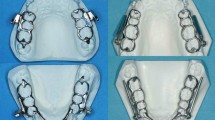Abstract
Objective:
To determine the influence of physiological growth pattern and anterior tooth inclination on the outcome in Class II patients treated with removable orthodontic plates and functional orthodontic appliances.
Patients and Methods:
After recruiting 50 patients with an upper anterior proclination of 1-SN ≥ 107° for this retrospective study, another 50 patients with a retroclination of 1-SN ≤ 95° were also included. All patients initially presented a skeletal Class II relationship with a distoclusion of at least one premolar width in the region of the first molars. All patients were evaluated separately by gender and additionally subdivided into three subgroups with a horizontal, neutral, or vertical craniofacial configuration. Treatment with removable orthodontic plates (pretreatment) and functional orthodontic appliances was initiated in mixed dentition. Pre- and post-treatment lateral cephalograms were evaluated for each patient.
Results:
Dento-alveolar analysis showed that the inclination of the upper incisors changed in the direction of the clinical standard value independent of the craniofacial configuration, although full correction using removable orthodontic plates and functional orthodontic appliances was not always achieved. Similarly good treatment outcomes were achieved with regard to overjet and overbite. The lower incisors of all patients were in proclination after treatment.
The ANB angle was reduced in both groups. Nevertheless, on average a skeletal Class II persisted in the Class II, Division 2 patients, while Class II, Division 1 patients with horizontal craniofacial configurations attained skeletal Class I.
Conclusions:
Treatment of Class II patients with removable appliances resulted in differences depending on anterior tooth inclination (Class II, Division 1 and II, Division 2) and craniofacial configuration. These differences must be taken into account during treatment planning. Complete treatment success with regard to sagittal jaw balance is very difficult to achieve with removable orthodontic plates (pre-treatment) and functional orthodontic appliances alone in Class II, Division 1 cases with a vertical craniofacial configuration and generally in Class II, Division 2 cases. A particularly favorable constellation for removable treatment is a Class II, Division 1 situation with a horizontal craniofacial configuration and retroclined or orthognathic mandibular anteriors.
Zusammenfassung
Fragestellung:
Wie wirken sich das physiologische Wachstumsmuster und die Frontzahninklination bei der Therapie mit abnehmbaren Platten und funktionskieferorthopädischen Geräten auf das Behandlungsergebnis der Klasse II aus?
Patienten und Methodik:
Nachdem für diese retrospektive Studie 50 Klasse-II/1-Patienten mit Proklination (1-SN ≥ 107°) rekrutiert waren, wurden weitere 50 Klasse-II/2-Patienten mit Reklination der Oberkieferfront (1-SN ≤ 95°) ausgewählt, die alle eine skelettale Klasse II mit einem Distalbiss von mindestens einer Prämolarenbreite im Bereich der 6-Jahr-Molaren aufwiesen. Alle Patienten wurden getrennt nach Geschlecht bewertet und zusätzlich in Gruppen mit horizontalem, neutralem und vertikalem Schädelaufbau unterteilt. Der Behandlungsbeginn der Therapie mit abnehmbaren Platten (Vorbehandlung) und funktionskieferorthopädischen Geräten fand im Wechselgebiss statt. Von jedem Patienten wurden ein prä- und posttherapeutisches Fernröntgenseitenbild ausgewertet.
Ergebnisse:
Die dentoalveoläre Analyse ergab, dass sich die Inklination der oberen Inzisivi unabhängig von der Wachstumsrichtung in allen Gruppen hin zu Normwerten veränderte, mit abnehmbaren Platten und funktionskieferorthopädischen Geräten aber nicht immer vollständig korrigieren ließ. Hinsichtlich des Overjets und Overbites wurden ähnlich gute Behandlungsergebnisse erzielt. Die unteren Inzisivi waren bei allen Patienten nach der Therapie prokliniert.
In beiden Gruppen reduzierte sich der ANB-Winkel. Trotzdem blieb bei den Klasse-II/2-Patienten die skelettale Klasse II im Durchschnitt bestehen. Die Klasse-II/1-Patienten mit horizontalem Schädelaufbau hingegen erreichten eine skelettale Klasse I.
Schlussfolgerungen:
Bei der Behandlung der Klasse II mit herausnehmbaren Apparaturen ergaben sich Unterschiede in der Abhängigkeit von der Frontzahninklination (Klasse II/1 und II/2) und der Wachstumsrichtung. Diese Unterschiede sind bei der Planung zu berücksichtigen. Allein mit abnehmbaren Platten (Vorbehandlung) und funktionskieferorthopädischen Geräten ist bei Klasse-II/1-Fällen mit vertikalem Wachstumsmuster und generell bei Klasse-II/2-Patienten bezüglich des sagittalen Kieferlageausgleichs ein vollständiger Therapieerfolg problematisch. Eine besonders günstige Konstellation für herausnehmbare Geräte besteht bei der Klasse II/1 mit horizontalem Schädelaufbau und rekliniert oder orthognath stehenden Unterkieferfrontzähnen.
Similar content being viewed by others
Author information
Authors and Affiliations
Corresponding author
Rights and permissions
About this article
Cite this article
Hönn, M., Schneider, C., Dietz, K. et al. Treating Class II Patients with Removable Plates and Functional Orthopedic Appliances. J Orofac Orthop 67, 272–288 (2006). https://doi.org/10.1007/s00056-006-0529-5
Received:
Accepted:
Issue Date:
DOI: https://doi.org/10.1007/s00056-006-0529-5
Key Words:
- Functional Orthodontics
- Retrospective study
- Class II, Division 1
- Class II, Division 2
- Craniofacial growth pattern
- Mixed dentition




